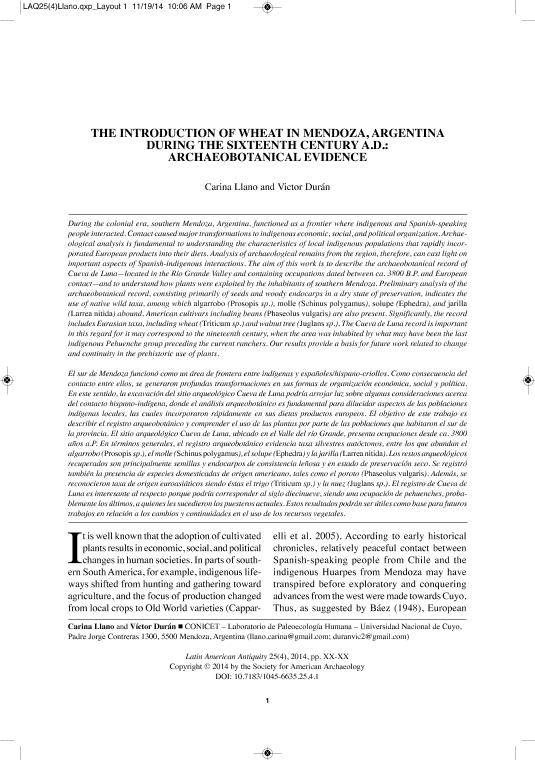Artículo
The introduction of Wheat in Mendoza, Argentina during the 16th Century A.D.: archaeobotanical evidence.
Fecha de publicación:
12/2014
Editorial:
Cambridge University Press
Revista:
Latin American Antiquity
ISSN:
1045-6635
Idioma:
Inglés
Tipo de recurso:
Artículo publicado
Clasificación temática:
Resumen
During the colonial era, southern Mendoza, Argentina, functioned as a frontier where indigenous and Spanish-speaking people interacted. Contact caused major transformations to indigenous economic, social, and political organization. Archaeological analysis is fundamental to understanding the characteristics of local indigenous populations that rapidly incorporated European products into their diets. Analysis of archaeological remains from the region, therefore, can cast light on important aspects of Spanish-indigenous interactions. The aim of this work is to describe the archaeobotanical record of Cueva de Luna—located in the Rio Grande Valley and containing occupations dated between ca. 3800 B.P. and European contact—and to understand how plants were exploited by the inhabitants of southern Mendoza. Preliminary analysis of the archaeobotanical record, consisting primarily of seeds and woody endocarps in a dry state of preservation, indicates the use of native wild taxa, among which algarrobo (Prosopis sp.), molle (Schinus polygamus), solupe (Ephedra), and jarilla (Larrea nitida) abound. American cultivars including beans (Phaseolus vulgaris) are also present. Significantly, the record includes Eurasian taxa, including wheat (Triticum sp.) and walnut tree (Juglans sp.). The Cueva de Luna record is important in this regard for it may correspond to the nineteenth century, when the area was inhabited by what may have been the last indigenous Pehuenche group preceding the current ranchers. Our results provide a basis for future work related to change and continuity in the prehistoric use of plants.
Palabras clave:
Archaeology
,
Archaeobotany
,
Central Western
,
Argentina
Archivos asociados
Licencia
Identificadores
Colecciones
Articulos(CCT - MENDOZA)
Articulos de CTRO.CIENTIFICO TECNOL.CONICET - MENDOZA
Articulos de CTRO.CIENTIFICO TECNOL.CONICET - MENDOZA
Citación
Llano, Carina Lourdes; Duran, Victor Alberto; The introduction of Wheat in Mendoza, Argentina during the 16th Century A.D.: archaeobotanical evidence.; Cambridge University Press; Latin American Antiquity; 25; 4; 12-2014; 462-472
Compartir
Altmétricas




